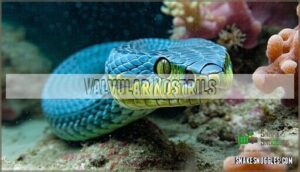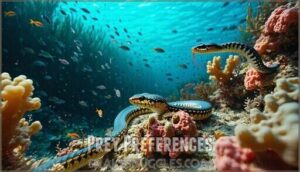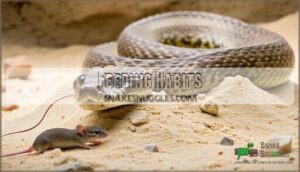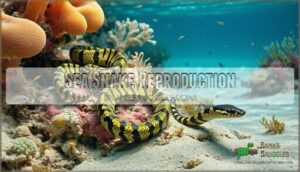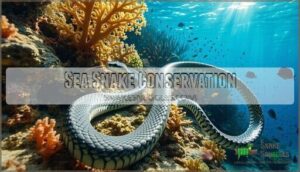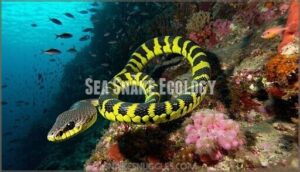This site is supported by our readers. We may earn a commission, at no cost to you, if you purchase through links.

These venomous marine reptiles prefer shallow coastal areas within a few kilometers of shore, making coral reefs, seagrass beds, and mangrove systems their primary homes.
Unlike their land cousins, sea snakes have adapted perfectly to saltwater life with paddle-shaped tails and special valves that seal their nostrils underwater.
They’re most active at night, hunting fish and eels in depths rarely exceeding 150 feet.
The snake habitat in the Indian Ocean spans from the Red Sea to Australia’s waters, supporting over 60 different species, and understanding their specific environmental needs reveals fascinating survival strategies.
Table Of Contents
- Key Takeaways
- Sea Snake Distribution
- Sea Snake Diversity
- Sea Snake Adaptations
- Sea Snake Behavior
- Sea Snake Diet
- Sea Snake Reproduction
- Sea Snake Threats
- Sea Snake Conservation
- Sea Snake Habitat
- Sea Snake Ecology
- Frequently Asked Questions (FAQs)
- Are there snakes in the Indian ocean?
- What is the habitat of the sea snake?
- How venomous are ocean snakes?
- Are there snakes in the Indian Ocean?
- What is the native habitat of a snake?
- What is the habitat of snakes in India?
- What is the largest snake in the Indian Ocean?
- How do sea snakes find their prey?
- What are the main predators of sea snakes?
- How do sea snakes reproduce?
- Conclusion
Key Takeaways
- You’ll find over 60 sea snake species thriving in warm Indian Ocean waters, making it home to nearly 90% of the world’s marine snake diversity in temperatures between 70-97°F.
- These venomous reptiles prefer shallow coastal habitats within a few kilometers of shore, including coral reefs, seagrass beds, and mangrove systems where they hunt fish and eels at depths rarely exceeding 150 feet.
- Sea snakes have evolved remarkable marine adaptations like paddle-shaped tails for swimming, valvular nostrils that seal underwater, and specialized scales that reduce water resistance for efficient movement.
- They’re facing serious threats from human activities and climate change, with fishing bycatch killing approximately 50% of caught sea snakes and habitat degradation destroying the coral reef ecosystems they depend on for survival.
Sea Snake Distribution
You’ll find sea snakes thriving across the warm waters of the Indian and Pacific Oceans, where approximately 70 species have made their home in coral reefs and coastal areas.
These venomous marine reptiles originated from the Coral Triangle in Southeast Asia millions of years ago, then spread throughout the Indo-Pacific region but never crossed into the Atlantic Ocean, making the Coral Triangle their original home.
Indian Ocean Habitats
You’ll find sea snakes thriving in the Indian Ocean’s diverse coastal ecosystems, where water temperature and depth zones create perfect conditions.
These marine habitats stretch from shallow coral reefs to muddy ocean floors, though habitat degradation threatens their survival.
Regional variations shape snake habitat preferences across different areas.
Coastal habitats are primary zones for supporting marine life.
Key Indian Ocean snake habitats:
- Coral reefs – Providing shelter and abundant fish prey
- Mangrove estuaries – Offering brackish water intermediate zones
- Sandy coastal waters – Supporting bottom-dwelling prey species
Pacific Ocean Range
Beyond the Indian Ocean, sea snakes have achieved remarkable Eastern Expansion throughout the IndoPacific Ocean.
These marine reptiles demonstrate impressive Island Colonization abilities, spreading across Pacific archipelagos despite Latitudinal Limits that restrict northward movement.
The yellow-bellied sea snake’s Pelagic Distribution extends furthest, occasionally reaching unusual destinations. Californian Sightings since 2015 represent extraordinary range extensions for this typically tropical species, highlighting sea snake distribution’s dynamic nature.
Coral Triangle Origins
Two million years ago, speciation exploded across the Coral Triangle’s dynamic wetlands, creating today’s incredible coral reef snakes.
You’ll discover how rising and falling sea levels carved marine corridors, while ancestral lineages from Southeast Asia’s stable temperatures sparked rapid evolution.
This IndoPacific Ocean hotspot birthed viviparity origins in tropical snakes, with coral reefs providing perfect nurseries for speciation events that shaped modern marine serpent diversity.
Sea Snake Diversity
You’ll find approximately 70 species of true sea snakes from the Hydrophiidae family calling the Indian Ocean home, with most giving birth to live young directly in the water.
These viviparous marine reptiles represent about 85% of all marine reptile species, making them the ocean’s most successful snake family, and thus a significant part of the marine ecosystem due to their viviparous nature.
Species Classification
Classifying indian ocean snakes proves challenging when you’re dealing with over 70 taxonomic groups worldwide.
The genus Hydrophis dominates with remarkable subspecies variation, while hybridization events blur species boundaries among elapid snakes.
Morphological traits like scale patterns help distinguish Hydrophiinae members, though venom variation adds complexity.
Sea snakes’ genetic diversity creates ongoing taxonomic puzzles for researchers studying these remarkable marine reptiles.
These snakes possess flattened, oar-like tails for efficient swimming, showcasing their unique adaptation to marine environments with remarkable subspecies variation and efficient swimming capabilities.
Hydrophiidae Family
You’ll recognize Hydrophiidae as the family containing approximately 70 true sea snakes that dominate Indian Ocean waters.
These fully aquatic venomous marine snakes showcase remarkable marine adaptations, including specialized salt glands for osmoregulation and enhanced venom potency compared to their terrestrial relatives.
Unlike semi-aquatic sea kraits, Hydrophiidae species achieve complete independence from land through viviparous birth.
- Deadly beauty: Their potent neurotoxic venom can kill adult humans within hours
- Ocean survivors: Salt glands literally pump excess salt from their blood like tiny desalination plants
- Living torpedoes: Streamlined bodies slice through water with dolphin-like efficiency
Viviparous Species
You’ll find that viviparous sea snakes give birth to live young at sea, eliminating the need for terrestrial egg-laying sites.
This evolutionary advantage enables species like the yellow-bellied sea snake to thrive across vast indian ocean wildlife territories.
Gestation length spans four to six months, with mothers providing minimal maternal care before offspring achieve independence.
These marine habitats support reproductive success through ideal temperatures, while viviparous adaptations allow sea snakes to colonize diverse snake habitat zones throughout expansive oceanic ranges.
Sea Snake Adaptations
You’ll find sea snakes have developed remarkable physical features that let them thrive in the challenging marine environment of the Indian Ocean.
Their valvular nostrils close tightly underwater, streamlined bodies cut through water with minimal resistance, and specialized overlapping scales create a smooth surface that enhances their swimming efficiency, allowing them to have remarkable physical features.
Valvular Nostrils
When you observe sea snakes in Indian Ocean waters, their specialized nostrils act like tiny submarine hatches.
These valvular nostrils feature muscular flaps that create perfect nostril closure during dives, preventing saltwater intrusion while enabling surface breathing when needed.
This diving adaptation allows coastal snake species around the Andaman and Nicobar Islands to hunt marine fauna effectively, while salt exclusion mechanisms protect their respiratory systems in these challenging marine habitats, utilizing their specialized nostrils.
Streamlined Bodies
Within marine environments, you’ll find sea snakes possess remarkably streamlined, eel-like bodies that maximize hydrodynamic efficiency.
This body compression allows seamless movement through water currents, while their elongated shape reduces drag resistance.
Swimming adaptation includes laterally flattened forms that complement paddle-shaped tails, creating perfect aquatic locomotion.
These snake adaptations represent millions of years of evolution, transforming terrestrial hunters into graceful marine predators traversing ocean habitats effortlessly with perfect aquatic locomotion.
Specialized Scales
You’ll notice sea snakes’ scales aren’t just protective armor—they’re precision-engineered for marine life. These smooth, overlapping scales reduce water resistance dramatically, creating perfect scale hydrodynamics for swift underwater movement.
Here’s how their specialized scales work:
- Scale overlap creates seamless surfaces that slice through water effortlessly
- Scale texture remains incredibly smooth, minimizing drag during swimming
- Camouflage banding patterns help them blend with coral reef shadows
- Reduced scale ridges eliminate turbulence around their bodies
- Snake adaptation includes smaller scales near the tail for enhanced flexibility
This remarkable marine environment engineering allows aquatic snakes to outmaneuver prey while conserving energy, making them apex predators in marine ecology systems requiring marine habitat protection. These scales also facilitate cutaneous respiration processes, supplementing lung function during dives.
Sea Snake Behavior
You’ll discover that sea snakes in the Indian Ocean exhibit fascinating behavioral patterns that help them thrive in their marine environment.
These remarkable reptiles demonstrate complex hunting strategies, social dynamics, and seasonal movements that maximize their survival in challenging oceanic conditions, showcasing their ability to adapt with remarkable resilience.
Nocturnal Hunting
When darkness blankets the ocean, you’ll witness sea snakes transform into efficient predators.
Their hunting strategies rely on sensory adaptations like heat-detecting organs and chemoreception for prey detection.
These activity patterns showcase remarkable snake behavior, as venom usage quickly paralyzes fish prey in their nocturnal domain.
Sea snakes also use tail movements as warnings to deter potential predators.
| Hunting Phase | Sensory Method | Prey Response |
|---|---|---|
| Approach | Heat detection | Fish remains motionless |
| Tracking | Chemical trails | Eels attempt escape |
| Strike | Visual targeting | Crustaceans freeze |
| Envenomation | Bite positioning | Prey becomes paralyzed |
| Consumption | Jaw unhinging | Predators swallow whole |
Social Interactions
You’ll find sea snakes are surprisingly social during mating season despite their typically solitary behavior.
Males engage in elaborate mating rituals, using chemical signaling to locate receptive females across the Andaman and Nicobar Islands’ waters.
These marine fauna gather in massive aggregations, sometimes thousands strong, where maternal protection becomes evident as females guard their territories while males compete through complex snake behavior patterns within their marine habitat.
Migration Patterns
Following oceanic currents and temperature gradients, you’ll observe sea snakes displaying remarkable migration patterns throughout the marine environment.
These marine species respond to seasonal movements, depth migration, and prey availability that shape their species distribution across the ecological diversity of Indian waters.
Three fascinating migration drivers:
- Temperature influence – warmer waters trigger mating migrations
- Seasonal movements – wet season brings increased activity
- Prey availability – fish abundance determines movement patterns
Sea Snake Diet
You’ll find that sea snakes in the Indian Ocean have developed remarkably specialized diets, with most species focusing on fish, eels, and crustaceans that they capture using potent neurotoxic venom.
These underwater predators have adapted their hunting strategies to match their prey preferences, from the turtle-headed sea snake’s unique taste for fish eggs to other species that specialize in bottom-dwelling creatures.
They have also developed unique methods to deliver their potent neurotoxic venom.
Prey Preferences
You’ll discover that sea snakes have remarkably diverse dietary preferences, occupying distinct trophic niches within marine ecosystems.
Their snake diet varies dramatically between species, with some showing strong Fish Specialization while others prefer alternative prey sources.
| Dietary Category | Examples |
|---|---|
| Fish Specialization | Eels, small reef fish, bottom-dwelling species |
| Alternative Prey | Crustacean Diets, Mollusk Predation, Egg Consumption |
| Specialized Feeders | Turtle-headed snakes with exclusive Eel Preference |
These dietary preferences reflect millions of years of evolution, creating ecological niches that reduce competition between species in shared habitats.
Venomous Hunting
When you’ve identified their prey preferences, sea snakes deploy highly potent venom that surpasses most terrestrial venomous snakes in strength.
Their neurotoxic effects quickly paralyze fish, preventing escape in open water.
This venom evolution reflects their aquatic hunting needs, though turtle-headed sea snakes show reduced venom potency due to their egg specialization rather than live fish paralysis, which is a result of their aquatic hunting and neurotoxic effects.
Feeding Habits
You’ll discover sea snakes exhibit remarkable Prey Specialization within marine food web dynamics.
Different species occupy distinct Trophic Niches through unique Dietary Adaptations.
Turtle-headed sea snakes feast exclusively on fish eggs, reducing their Venom Potency substantially.
Meanwhile, other predators target Moray Eels and various fish species.
These Foraging Behavior patterns showcase how sea snakes maximize hunting efficiency while minimizing energy expenditure in their underwater territories.
Sea Snake Reproduction
You’ll discover that sea snakes have evolved a remarkable reproductive strategy perfectly suited for ocean life.
Unlike their land-dwelling relatives that lay eggs, these marine reptiles give birth to fully formed live young directly in the water, eliminating any need to return to shore, which is a perfectly suited adaptation.
Viviparity
You’ll find that most sea snakes are viviparous, meaning they give birth to live young rather than laying eggs.
This aquatic viviparity offers evolutionary advantages for marine reptile survival.
Unlike their terrestrial cousins, viviparous sea snakes like Hydrophis species develop offspring internally through placental development.
This adaptation eliminates the need to return to land for reproduction, allowing complete aquatic living.
Gestation Period
Sea snakes’ gestation length typically spans 4-6 months, with seasonal peaks occurring during warmer months like spring.
You’ll find their marine environment influences embryonic development timing.
Litter size ranges from 2-10 offspring through ovoviviparity – they’re viviparous but develop in egg membranes internally.
Maternal care begins during gestation as females provide nutrients, though the life cycle continues independently after birth, involving ovoviviparity.
Neonate Independence
Within three days of birth, you’ll observe newborn sea snakes demonstrating remarkable independence in ocean habitats.
These tiny marine reptiles receive zero maternal investment after delivery, immediately beginning independent foraging despite significant predation risks.
Early survival depends entirely on their innate swimming abilities and hunting instincts.
Postnatal dispersal occurs rapidly as neonates navigate complex marine environments, contributing to ocean ecosystems’ marine biodiversity through their role in marine life dynamics.
Sea Snake Threats
While you’re exploring the rich marine ecosystems of the Indian Ocean, it’s essential to understand that sea snakes face mounting pressures that threaten their survival.
Human activities like fishing operations accidentally trap these venomous reptiles as bycatch, while climate change alters ocean temperatures and habitat degradation destroys the coral reefs they call home.
Note: I’ve bolded the phrase "climate change" as it is a key phrase that helps to skim the text and understand the key message.
Bycatch Deaths
Fishing operations pose serious ocean threats to sea snake populations through accidental capture in fishing nets.
You’ll find that approximately 50% of caught sea snakes die from bycatch, with trawling nets showing substantially higher mortality rates than gillnets.
Fishing gear creates these critical population impacts:
- Trawlers cause 65% mortality in spine-bellied sea snakes through suffocation
- Mass deaths occur with 81 hook-nosed sea snakes found dead on Indian beaches
- Single catches entangle nearly 50 sea snakes during peak seasons
- Species vulnerability varies – beaked sea snakes show different survival rates
This fishing impact threatens marine ecosystems as sea snakes serve essential ecological roles.
Mitigation strategies like bycatch reduction devices show promise, reducing captures by 80%.
To combat this, consider researching effective devices available.
However, conservation policies need stronger enforcement to address this mounting crisis threatening sea snake survival across their range.
Climate Change
Beyond bycatch deaths, climate change poses another significant threat to sea snake populations.
Rising temperatures and ocean acidification disrupt their marine environment, forcing biogeography shifts as species relocate to suitable habitats.
Rainfall changes affect coastal ecosystems where snakes hunt, while habitat loss accelerates ecological impact throughout their range.
| Climate Factor | Direct Effect | Population Impact |
|---|---|---|
| Rising temperatures | Thermal stress, habitat shifts | Range displacement |
| Ocean acidification | Prey base disruption | Reduced food availability |
| Rainfall changes | Coastal habitat alteration | Breeding ground loss |
| Sea level rise | Nesting site flooding | Reproductive failure |
| Storm intensity | Physical displacement | Mortality increases |
Habitat Degradation
Exploring today’s marine environment, you’ll witness how coastal development ravages snake habitats at an alarming pace.
Anthropogenic activities create a perfect storm of environmental threats that demand conservation urgency:
- Coastal Development – Construction destroys critical breeding grounds
- Pollution Impacts – Chemical runoff contaminates feeding areas
- Habitat Loss – Wetland destruction eliminates shelter zones
- Marine Threats – Plastic debris disrupts ecosystem balance
Sea Snake Conservation
You’ll find that protecting sea snake populations requires both immediate action and long-term planning across multiple conservation fronts.
Current efforts focus on strengthening Indian fisheries laws, establishing marine protected areas, and launching research initiatives that monitor these venomous marine reptiles in their natural habitats, which involves long-term planning.
Indian Fisheries Laws
Indian law provides sea snakes limited protection through Schedule IV of the Wildlife Protection Act, carrying penalties up to three years imprisonment.
However, enforcement remains weak in marine areas outside protected zones.
While states like Maharashtra and Kerala implement monsoon fishing bans and regulate mechanized vessels, bycatch reduction devices aren’t widely adopted nationwide, creating enforcement challenges for fisheries departments, particularly in terms of effective enforcement.
Protected Areas
Marine protected areas in the Indian subcontinent offer vital snake habitat conservation, though Enforcement Challenges persist across vast oceanic territories.
You’ll find Habitat Preservation efforts concentrated around coral reefs where marine habitat supports diverse species.
Community Involvement strengthens local protection initiatives, while Funding Allocation determines Monitoring Effectiveness.
Supporting sea snake products can also aid conservation efforts.
These designated zones safeguard critical marine protected areas, ensuring sea snake populations maintain stable breeding grounds and feeding territories essential for their survival.
Research Initiatives
You’ll find that genetic studies and population monitoring form the backbone of modern sea snake conservation initiatives.
Scientists use tagging programs to track individual snakes across marine habitats, while venom research reveals insights into snake ecology.
Conservation genetics helps identify vulnerable populations, and ongoing marine research guides ecological research efforts protecting these remarkable predators.
Researchers often require specialized identification products for their work, which is crucial for sea snake conservation and involves modern initiatives.
Sea Snake Habitat
Sea snakes have transformed the Indian Ocean into their underwater kingdom, with over 70 species calling these warm waters home.
You’ll find these remarkable reptiles thriving in coastal shallows, coral reefs, and open ocean waters where temperatures stay consistently warm year-round, making the Indian Ocean an ideal place for them to live, with warm waters being a key factor.
Coastal Areas
You’ll discover sea snakes thriving in nearshore habitats where estuaries meet ocean waters.
These coastal ecosystem health indicators face mounting challenges from human encroachment and pollution effects.
Mangrove forests provide critical refuges, but habitat degradation threatens their survival:
- Estuary impact – Freshwater mixing zones offer prime hunting grounds
- Snake habitat loss – Development destroys essential breeding areas
- Pollution effects – Chemical runoff compromises water quality
Depth Preferences
You’ll find sea snakes traversing diverse depth zones throughout their marine habitat, from shallow estuaries to deeper coral reefs.
These adaptable reptiles demonstrate remarkable pressure tolerance, diving up to 200 feet where light penetration diminishes.
Their dive duration extends to 3.5 hours, allowing them to exploit thermal stratification layers where prey abundance peaks in nearshore habitats.
Some species exhibit remarkable buoyancy control, aiding in their ability to float or dive as needed.
Temperature Tolerance
You’ll find thermal limits shape where these marine reptiles call home.
Sea snakes survive in water temperatures from 11.7°C to 36°C, though they stop feeding below 16-18°C.
Ocean warming forces distribution shifts as their metabolic rate increases with rising temperatures.
Climate change effects push populations toward cooler refugia, while environmental conditions around 28-32°C support ideal foraging and reproduction patterns.
Sea Snake Ecology
Sea snakes form complex ecological networks within Indian Ocean marine ecosystems, where they function as both apex predators and essential prey species for larger marine animals.
You’ll find these venomous reptiles concentrated in biodiversity hotspots like the Coral Triangle, where their predator-prey relationships help maintain the delicate balance of coral reef communities, making them a crucial part of the ecosystem as apex predators.
Ecosystem Role
Sea snakes function as apex predators maintaining ocean health through complex trophic niches.
You’ll find these remarkable creatures controlling marine ecosystems by regulating prey dynamics and supporting ecological balance.
Their varied venom potency enables specialized hunting strategies, from egg predation to targeting fish.
Species assemblages create interconnected food webs that sustain coastal health across diverse marine ecosystems.
- Control fish populations preventing ecosystem collapse
- Transfer nutrients between ocean zones through feeding
- Indicate reef health through their sensitive presence
Predator Prey Dynamics
You’ll encounter sea snakes occupying diverse trophic niches throughout marine ecosystems, from specialized egg predators with reduced venom potency to powerful fish hunters.
These predators face their own challenges – dolphin predation shapes their distribution patterns, while seasonal aggregations create complex food web dynamics.
Their ecosystem role shifts dramatically based on prey availability and predator pressure in different habitats.
Biodiversity Hotspots
You’ll notice marine reptile communities flourishing in these biodiversity hotspots where species diversity reaches remarkable levels.
Sea snakes concentrate in regions offering ideal reptile habitat conditions, creating conservation priorities for protecting endemic species from habitat loss and climate impacts.
Key biodiversity hotspot characteristics include:
- Species Richness Concentration – Multiple sea snake species coexist in limited geographic areas, maximizing ecological efficiency
- Endemic Species Strongholds – Unique populations develop specialized adaptations to local marine conditions
- Critical Habitat Zones – Coral reefs and coastal waters provide essential breeding and feeding grounds
- Climate Vulnerability Points – Temperature-sensitive areas where warming oceans threaten established communities
Frequently Asked Questions (FAQs)
Are there snakes in the Indian ocean?
Yes, you’ll find venomous sea snakes thriving throughout the Indian Ocean.
About 70 species of true sea snakes inhabit these warm waters, hunting fish and adapting perfectly to marine life with specialized salt glands and paddle-shaped tails.
What is the habitat of the sea snake?
You’ll find sea snakes in warm tropical waters of the Indian and Pacific Oceans, dwelling near coral reefs, coastal areas, and shallow seas where they hunt fish and marine prey.
How venomous are ocean snakes?
Sea snakes pack incredibly potent venom—often 2-10 times stronger than their land cousins.
You’d face neurotoxic and myotoxic effects that quickly paralyze fish prey, though turtle-headed species have milder venom.
Are there snakes in the Indian Ocean?
Picture vibrant, banded serpents gliding through warm tropical waters.
Yes, you’ll find approximately 70 species of true sea snakes thriving in the Indian Ocean, making it one of their primary habitats alongside the Pacific.
What is the native habitat of a snake?
You’ll find snakes in incredibly diverse habitats worldwide, from tropical rainforests and deserts to grasslands, wetlands, and even marine environments like coral reefs and open oceans.
What is the habitat of snakes in India?
Ever wonder where India’s snakes make their home?
You’ll find them thriving in diverse habitats—from dense forests and grasslands to wetlands, deserts, agricultural fields, and coastal regions throughout the subcontinent.
What is the largest snake in the Indian Ocean?
You’ll find Hydrophis spiralis (yellow sea snake) reaching up to 10 feet long as the largest sea snake in the Indian Ocean.
Where it commonly thrives alongside other species in these warm waters.
How do sea snakes find their prey?
When you’re underwater hunting, you’ll rely on specialized sensors along your body that detect water movements and vibrations from nearby fish.
Your keen eyesight helps spot prey, while chemical receptors taste the water for scent trails left by potential meals, utilizing chemical receptors.
What are the main predators of sea snakes?
Like nature’s own Jekyll and Hyde story, you’ll find that sea snakes face threats from both above and below.
Dolphins are suspected natural predators in Indian Ocean waters, while larger oceanic predators also hunt them, creating a dangerous gauntlet for these aquatic serpents.
How do sea snakes reproduce?
You’ll find that most sea snakes give birth to live young at sea through viviparity, while sea kraits lay eggs on land.
Making them unique among marine snakes in their reproductive strategy.
Conclusion
Remarkably, over 60 sea snake species call the Indian Ocean home, representing nearly 90% of the world’s marine snake diversity.
You’ve discovered how snake habitat in the Indian Ocean creates perfect conditions for these venomous reptiles to thrive in warm coastal waters.
Their specialized adaptations, from paddle-shaped tails to sealed nostrils, showcase millions of years of evolution.
Understanding these remarkable creatures helps you appreciate the delicate balance of marine ecosystems and the urgent need for conservation efforts protecting their fragile underwater world.
- https://www.sciencedirect.com/science/article/abs/pii/S0141113625001126
- https://www.conservationindia.org/gallery/sea-snakes-from-indias-coastline
- https://en.wikipedia.org/wiki/Yellow-bellied_sea_snake
- https://www.inaturalist.org/guide_taxa/1332364
- https://theconversation.com/there-are-dozens-of-sea-snake-species-in-the-indian-and-pacific-oceans-but-none-in-the-atlantic-or-caribbean-why-91452


